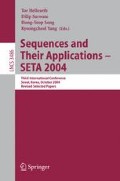Abstract
We enumerate the inequivalent self-dual additive codes over GF(4) of blocklength n, thereby extending the sequence A090899 in The On-Line Encyclopedia of Integer Sequences from n = 9 to n = 12. These codes have a well-known interpretation as quantum codes. They can also be represented by graphs, where a simple graph operation generates the orbits of equivalent codes. We highlight the regularity and structure of some graphs that correspond to codes with high distance. The codes can also be interpreted as quadratic Boolean functions, where inequivalence takes on a spectral meaning. In this context we define PAR IHN , peak-to-average power ratio with respect to the {I,H,N}n transform set. We prove that PAR IHN of a Boolean function is equivalent to the the size of the maximum independent set over the associated orbit of graphs. Finally we propose a construction technique to generate Boolean functions with low PAR IHN and algebraic degree higher than 2.
Access this chapter
Tax calculation will be finalised at checkout
Purchases are for personal use only
Preview
Unable to display preview. Download preview PDF.
References
Calderbank, A.R., Rains, E.M., Shor, P.M., Sloane, N.J.A.: Quantum error correction via codes over GF(4). IEEE Trans. Inform. Theory 44, 1369–1387 (1998), http://arxiv.org/quant-ph/9608006
Rains, E.M., Sloane, N.J.A.: Self-dual codes. In: Pless, V.S., Huffman, W.C. (eds.) Handbook of Coding Theory, pp. 177–294. Elsevier, Amsterdam (1998), http://arxiv.org/math/0208001
Höhn, G.: Self-dual codes over the Kleinian four group. Mathematische Annalen 327, 227–255 (2003), http://arxiv.org/math/0005266
Hein, M., Eisert, J., Briegel, H.J.: Multi-party entanglement in graph states. Phys. Rev. A 69 (2004), http://arxiv.org/quant-ph/0307130
Glynn, D.G., Gulliver, T.A., Maks, J.G., Gupta, M.K.: The geometry of additive quantum codes. Springer, Heidelberg (2004) (submitted)
Sloane, N.J.A.: The On-Line Encyclopedia of Integer Sequences (2004), Web page http://www.research.att.com/~njas/sequences/
Danielsen, L.E.: Database of self-dual quantum codes (2004), Web page http://www.ii.uib.no/~larsed/vncorbits/
Schlingemann, D., Werner, R.F.: Quantum error-correcting codes associated with graphs. Phys. Rev. A 65 (2002), http://arxiv.org/quant-ph/0012111
Grassl, M., Klappenecker, A., Rotteler, M.: Graphs, quadratic forms, and quantum codes. In: Proc. IEEE Int. Symp. Inform. Theory, p. 45 (2002)
Glynn, D.G.: On self-dual quantum codes and graphs. Submitted to Elect. J. Combinatorics (2002), http://homepage.mac.com/dglynn/.cv/dglynn/Public/SD-G3.pdf-link.pdf
Van den Nest, M., Dehaene, J., De Moor, B.: Graphical description of the action of local Clifford transformations on graph states. Phys. Rev. A 69 (2004), http://arxiv.org/quant-ph/0308151
Parker, M.G., Rijmen, V.: The quantum entanglement of binary and bipolar sequences. In: Helleseth, T., Kumar, P.V., Yang, K. (eds.) Sequences and Their Applications, SETA 2001. Discrete Mathematics and Theoretical Computer Science Series. Springer, Heidelberg (2001), http://arxiv.org/quant-ph/0107106 (long version)
Bouchet, A.: Isotropic systems. European J. Combin. 8, 231–244 (1987)
Bouchet, A.: Recognizing locally equivalent graphs. Discrete Math. 114, 75–86 (1993)
McKay, B.D.: nauty User’s Guide (2004), http://cs.anu.edu.au/~bdm/nauty/nug.pdf
Gulliver, T.A., Kim, J.-L.: Circulant based extremal additive self-dual codes over GF(4). IEEE Trans. Inform. Theory 50, 359–366 (2004)
Grassl, M.: Bounds on d min for additive [[n,k,d]] QECC (2003), Web page http://iaks-www.ira.uka.de/home/grassl/QECC/TableIII.html
Riera, C., Petrides, G., Parker, M.G.: Generalized bent criteria for Boolean functions. Technical Report 285, Dept. of Informatics, University of Bergen, Norway (2004), http://www.ii.uib.no/publikasjoner/texrap/pdf/2004-285.pdf
Parker, M.G.: Generalised S-box nonlinearity. NESSIE Public Document, NES/DOC/UIB/WP5/020/A (2003), https://www.cosic.esat.kuleuven.ac.be/nessie/reports/phase2/SBoxLin.pdf
Danielsen, L.E., Gulliver, T.A., Parker, M.G.: Aperiodic propagation criteria for Boolean functions. Submitted to Inform. Comput. (2004), http://www.ii.uib.no/~matthew/GenDiff4.pdf
Radziszowski, S.P.: Small Ramsey numbers. Elect. J. Combinatorics, Dynamical Survey DS1, 1–42 (2002), http://www.combinatorics.org/Surveys/ds1.pdf
Arratia, R., Bollobás, B., Sorkin, G.B.: The interlace polynomial of a graph. J. Combin. Theory Ser. B 92, 199–233 (2004), http://arxiv.org/math/0209045
Aigner, M., van der Holst, H.: Interlace polynomials. Linear Algebra and its Applications 377, 11–30 (2004)
Riera, C., Parker, M.G.: Spectral interpretations of the interlace polynomial. Submitted to WCC 2005 (2004), http://www.ii.uib.no/~matthew/WCC4.pdf
Parker, M.G., Gulliver, T.A.: On graph symmetries and equivalence of the six variable double-clique and wheel (2003) (Unpublished)
Parker, M.G., Tellambura, C.: A construction for binary sequence sets with low peak-to-average power ratio. In: Proc. IEEE Int. Symp. Inform. Theory, p. 239 (2002), http://www.ii.uib.no/~matthew/634isit02.pdf
Parker, M.G., Tellambura, C.: A construction for binary sequence sets with low peak-to-average power ratio. Technical Report 242, Dept. of Informatics, University of Bergen, Norway (2003), http://www.ii.uib.no/publikasjoner/texrap/pdf/2003-242.pdf
Davis, J.A., Jedwab, J.: Peak-to-mean power control in OFDM, Golay complementary sequences and Reed-Muller codes. IEEE Trans. Inform. Theory 45, 2397–2417 (1999)
Author information
Authors and Affiliations
Editor information
Editors and Affiliations
Rights and permissions
Copyright information
© 2005 Springer-Verlag Berlin Heidelberg
About this paper
Cite this paper
Danielsen, L.E., Parker, M.G. (2005). Spectral Orbits and Peak-to-Average Power Ratio of Boolean Functions with Respect to the {I,H,N}n Transform. In: Helleseth, T., Sarwate, D., Song, HY., Yang, K. (eds) Sequences and Their Applications - SETA 2004. SETA 2004. Lecture Notes in Computer Science, vol 3486. Springer, Berlin, Heidelberg. https://doi.org/10.1007/11423461_28
Download citation
DOI: https://doi.org/10.1007/11423461_28
Publisher Name: Springer, Berlin, Heidelberg
Print ISBN: 978-3-540-26084-4
Online ISBN: 978-3-540-32048-7
eBook Packages: Computer ScienceComputer Science (R0)

